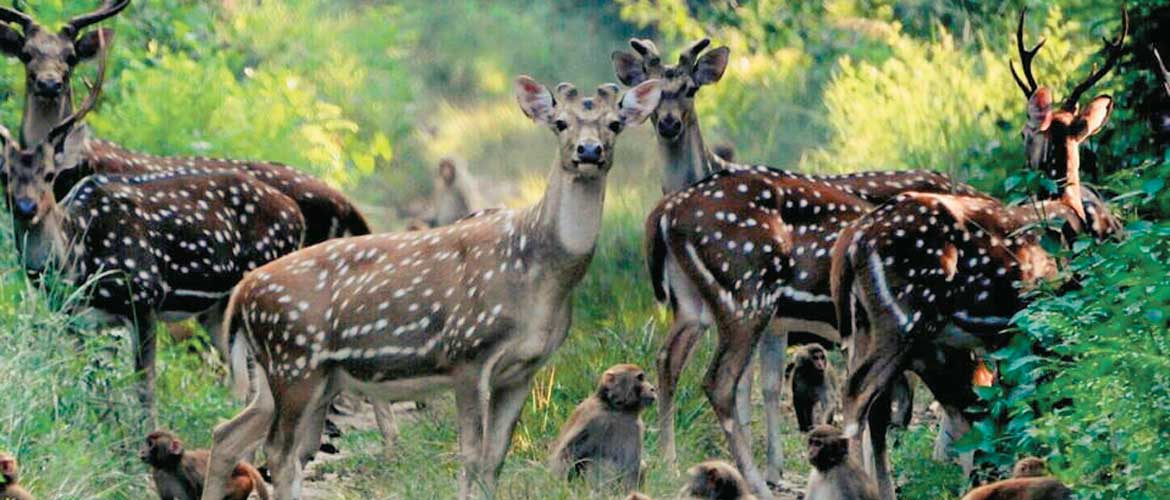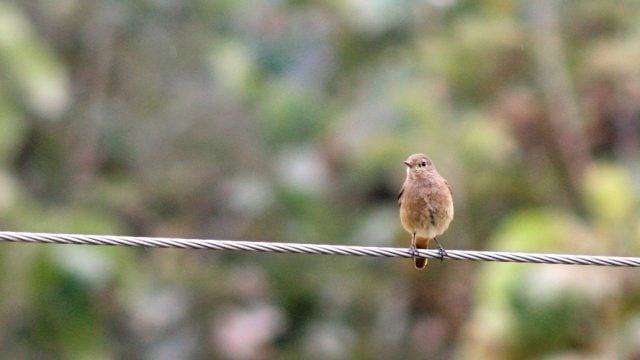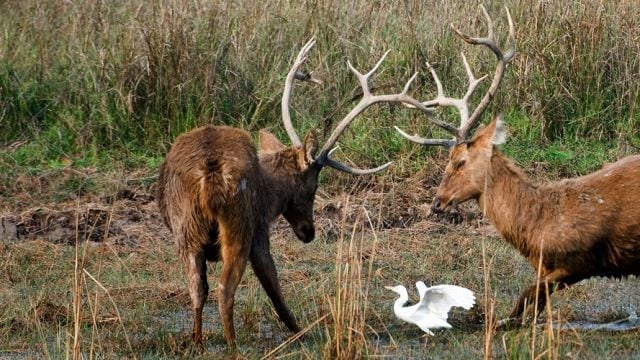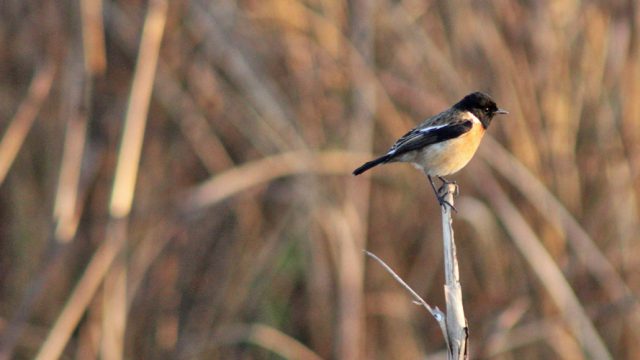Pavankali winked at me. The big, beautiful elephant had just met us, moments before our
We were in the middle of a forest. Tall, old sal trees were meditatively swaying all around us, densely clustered in their solitude; so lost in their own world that they wouldn’t even allow sunlight to pass through. Somewhere through a slight opening in the leaves, a sunbeam hit a tensile spider’s web on a bark and another on Pavankali’s trunk.

I was beaming with excitement. After all my secret finger-crossing and hoping against hope, I had bumped into an insider, a mahout who lived in these jungles, and who could actually confirm, even in his casual comments, that tigers indeed could be seen in Dudhwa.
Pavankali was the result of an undisguised blessing called the Tiger Census. Dudhwa has one pucca road running through it and various kuccha but motorable forks that lead deeper into the jungle. The tiger census meant that these forks had been cleaned and the dust smoothened to make about 5-ft-long ‘pads’ at regular intervals. As the tiger would step on one, his or her pug-marks, individual and identifiable, would impress themselves on it. Since vehicles would obliterate such pugmarks, the park had been closed to tourists during the time of the census. It was during such an exercise that as a journalist, I got a chance to visit the park and explored the area while sitting on Pavankali, and thereby keeping clear of the pads.
Pavankali demonstrated the reason why ancient Indian texts compared the walk of an actress to that of an elephant. Pavankali bore us patiently, walking slowly with her hip swinging from side to side, taking us through the moist sal forest for an enchanting hour. We hung to the wooden legs of the charpai that was our seat. After a while, she waded into a grassland.
Tigers, the mahout told us, don’t walk the forest floor at random. They prefer the pagdandis (mud tracks) maybe because scrunching leaves on the forest floor impedes stealth hunting. That’s why census pads are made only on these paths and that’s why our mahout,who seemed to carry knowledge of the area in his blood, confidently pointed and said, ‘‘That’s where he’ll emerge’’. Pavankali set off again this time at what she clearly thought was a trot. We were not chasing the tiger (which would be bad practice), but, having calculated where he would emerge in the arterial path, we were trying to reach a point on the path ahead of him, so we could see him again without making him feel threatened.
He emerged at the expected spot, saw us ahead on the road and stood assessing possibilities while we gloated some more and drank in the spectacle. When he moved away, there was an orgy of self-congratulations. We patted the mahout on the back, he felicitated us and Pavankali ambled along with an added spring in her step when suddenly, the driver made an announcing-the-presence sound again. We whipped around. There, like a kitten peeping from behind the kitchen door to see if the milk pot is unguarded, was our very own feline, peeping at us from behind a bend in the road, suddenly looking quite adorable with his whiskers and huge eyes. We never saw him again. But I carried him with me through the rest of the journey.

The forest staff had so kindly let us be a part of the tiger census. The reality of wildlife and the forest is borne by these men, who patrol the jungles on cycle or on foot, alone or in pairs, with no means of communication, their salaries as little as Rs.4,500–6,000 and if they come up against a gang of poachers, who would know. But they beamed with enormous pride as they showed me an empty pad and the pugmarks around it.
It was out of affection that they had given names such as Bankey (dandy) and Pavitri (the pure one) to a pair of happily, messy, mud-splattered one-horned rhinos that I saw the next day. Pavankali having basely deserted me, I saw these two while sitting atop Roopkali, who waded down at a precipitous angle into the swamp in which the happy couple were positively wallowing.
The ‘horn’ – a knob of matted hair projecting from their snout – may have evoked images of heavenly unicorns in some, but the rhinos actually had the look of something from below the earth. They did not mock-charge us, though Bankey looked like he might try to since the elephant looked so inviting. He settled for gazing balefully.
Found only in Assam’s Kaziranga forests, heavily poached for the supposed aphrodisiac quality of their horn, the endangered rhinos are a compelling reason to visit Dudhwa even if they are an introduced species here. Actually, there are more compelling reasons – no guides, no cars, nothing much by way of infrastructure. Just the ecosystem and you, trying to find your place within it and building a relationship with it.
ORIENTATION
Two rivers form the park’s boundaries; Mohana to the north, along the Indo-Nepal border, and Suheli to the south. The Kishanpur Sanctuary, which is one of the two core areas of the tiger reserve (the other being Dudhwa itself), lies to the southwest of Dudhwa, spread across Lakhimpur-Kheri and Shahjahanpur districts. The Salukhapur Range hosts a rhino zone, 13km to the southwest of Dudhwa Reserve.
The small town of Palia is 10km from the park’s main gate. The best point to start your trip is at the Dudhwa Forest Office near the main gate. Here, you can get information from the forest officials about the availability of rooms in the log huts and elephant safari timings. Dudhwa is administratively divided into nine ranges. Of these, only the range offices at Sathiana, Bankati, Sonaripur, Salukhapur, Belrayan and Kila have guesthouses.
The forest provides no jeep safaris or guides, though the mahouts, as my experience shows, make very useful guides. If you want to drive around the forest, but have no vehicle, you can hire one from Palia for the length of your stay. Sunil Aggarwal (Cell: 09415489582) rents taxis.
◆Entry ₹2,500 (6 pax, includes guide and vehicle fee) Timings 7:00–10.00am; 3:00–5.30pm
THINGS TO SEE AND DO
Tourists can either opt for a jeep or an elephant safari in Dudhwa. While you can drive to various parts of the park, chances of animal sightings are higher during an elephant ride.
Elephant Safari
Elephants can only be hired from the main Dudhwa office near the park gate and from Salukhapur Chowki. The charges are Rs.100 per person for about 3hrs. Four people can comfortably sit on an elephant. The mahout is a storehouse of information and doubles up as a guide, so it is advisable to tip him well.
The Dudhwa Office has a library and interpretation centre. Nearby is a shop that sells books autographed by Billy Arjan Singh, Dudhwa T-shirts and literature.
Rhino Range
The one-horned rhinos are kept separately in the Salukhapur Range. You can drive in the area, but this will restrict you till the main roads and you may not see any rhinos at all. It’s best to drive to Salukhapur Chowki and hire an elephant there.

A touch of Rajasthan
Do not miss the fascinating story of the Tharu tribals who live inside the park. Legend has it that during the Haldighati battle, some Rajasthani women and children from the families of Maharana Pratap’s sol-diers, were sent to these jungles with their servants.
After the soldiers perished, their wives set up families with the servants and settled in the area. That is why the Tharu tribe living in Dudhwa today (there are about 37 villages inside the park) gives a higher social status to women. As they are close to the border of Nepal, there has been intermixing over the years and seeing a Nepali face with the ghaghra, choli and chunky jewellery typical of Rajasthan is striking. The Tharu villages are divided into two clusters, Bankati (to the northeast of the reserve) and Chandan Chowki (southeast of Bankati). The main motorable road that runs through the park passes through these clusters, and the closest cluster is a 15-minute drive from the main office.
Kishanpur Sanctuary
The sanctuary is 30km from Dudhwa on the Palia-Shahjahanpur road, beyond the Sarda river. Ask the forest staff to direct you to Jhaddi Taal.
WHERE TO STAY AND EAT
Dudhwa and the adjoining Palia town has a few hotels, while the national park has some rest houses with basic facilities. Dudhwa Forest Rest House (Tariff: ₹500) at the main range office is the best bet for accommodation because it has electricity, an inverter and a canteen with simple vegetarian food. Adjacent to it are 14 cottages (Tariff: ₹3,000) and two 10-bedded dorms (Tariff: ₹1,000, includes two meals and free entry) managed by UP Ecotourism. Boo-kings can be made online at W upecotourism.in or at the office of the Regional Manager (Ecotourism), Lucknow (Tel: 0522-6568121).
The other forest rest houses (Bookings Tel: 05872-252106) are located at the range offices in Bankati, Belrayan, Kila, Salukhapur, Sonaripur and Sathiana. Currently, Bankati and Sathiana are operational. There is a canteen at Bankati, but you have to carry provisions to Sathiana.
Outside the park, The Tree of Life Jaagir Lodge (Cell: 09602091000/ 2000; Tariff: ₹17,000–21,000, with meals) is a 5-star luxury property with villas and suites. Dudhwa Tigerhino Resort (Tel: 209155, Cell: 07388655595, 08009006191; Tariff: ₹1,800–2,500) in Bansi Nagar has 12 spacious and clean rooms with a restaurant. They can arrange safaris for you. Also in Bansi Nagar is UP Tourism’s Tiger Den Resort (Lucknow Tel: 0522-2304870), which was undergoing renovation at the time the book went to print.
There’s a Lifetime in his Legend
Billy Arjan Singh, 1917–2010
No photograph of mother and child has ever brimmed with such love. A tigress and a man are hugging. The man has had to bend his head much further than an ordinary hug would require, while the tigress has settled on her hind feet and looms over the man, making late Billy Arjan Singh, weight-lifter, grand old man of Indian conservation, winner of the J Paul Getty Award (‘the environmental Nobel’) seem like her prematurely balding son.

Billy’s was a life that depicted the beauty, possibility and amazing potential of human transformation. Born to the princely Kapurthala clan in 1917, he shot his first leopard at 12 and his first tiger at 14. After years of weightlifting, an unhappy stint with the army and a happier one with farming, he finally settled in 1959 in a remote part of the Kheri District to start the farm that the world knows as Tiger Haven today. Even now, you can imagine why he chose the spot – far from civilisation, at the edge of two rivers, with tall sal trees stretching all the way to Nepal for a background. In 1960, Billy the farmer-hunter was driving in the dark when he saw a tiny green gleam. He shot, and the gleam went out. It was a big leopard and as Billy “watched the fire fade from his eyes… I felt an awful confusion – futility of the destruction of beauty and the taking of life. I put aside my rifle…”
To Billy, the problem of fast vanishing wildlife came home in the form of the tragically diminished herd of barasingha left in the forest near his farm. He personally created a safer patch for them, keeping poachers and woodcutters at bay, and lobbied to have the forest declared a wildlife sanctuary, which was done in 1964 and known as Dudhwa. With the years, Billy continued his fierce personal patrolling of the jungle, his war against poachers and policies, his bitter critique of the forest department for its commercial exploitation of the forests and his exposure of the failures of Project Tiger. In the 1970s, he bred three leopards – Prince, Harriet and Juliet – and the legendary tigress Tara on his farm to prove that animals born in captivity could be rehabilitated in the forest. The experiments were a mixed success, with Billy believing that Prince and Tara had indeed successfully taken to the wild, leaving him with a life-long debate with experts on the introduction of Tara’s Siberian genes in the Indian species.
Billy had made more enemies than friends. In his defence of forests, he had made no distinction between the greedy official and the impoverished tribal who may not survive without forest produce. But then, perhaps, it took such a man to make his own mother, uncomfortable with his adopted big cats, stay in a wire enclosure with a thatched roof, while the cats roamed about freely; he even called it ‘granny’s cage’! Perhaps, it took such a man to hug a tiger.
GETTING THERE
Air Nearest airport: Lucknow (200km/ 4hrs). Taxi costs ₹3,000 for drop
Rail Nearest railhead: Shahjahanpur (84km/ 2.5hrs). Taxi costs ₹2,000 (return)
Road Connected to Delhi via Moradabad, Bareilly, Shahjahanpur, Khutar and Palia (10km away)
FAST FACTS
When to go October–March
Wildlife/ Forest Dept Office
Deputy director, Dudhwa NP
Lakhimpur Kheri. Tel: 09452162054
STD code 05278
State Uttar Pradesh
Location In Lakhimpur Kheri District in north Uttar Pradesh, with the Indo-Nepal border to its north
Distance 430km E of Delhi, 201km NW of Lucknow
Route from Delhi NH24 to Shahjahanpur via Ghaziabad, Moradabad, Rampur and Bareilly; district road to Dudhwa National Park via Pawayan, Kutar, Mailani, Bhira and Palia
North Zone
Uttar Pradesh
Wildlife Holidays of India





